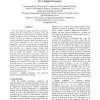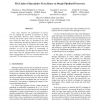76 search results - page 8 / 16 » Redundancy in Instruction Sequences of Computer Programs |
CF
2005
ACM
13 years 9 months ago
2005
ACM
This paper evaluates how much extended dictionary-based code compression techniques can reduce the static code size. In their simplest form, such methods statically identify ident...
IEEEPACT
2005
IEEE
14 years 1 months ago
2005
IEEE
VLIW architectures are popular in embedded systems because they offer high-performance processing at low cost and energy. The major problem with traditional VLIW designs is that t...
IRI
2006
IEEE
14 years 1 months ago
2006
IEEE
With the rapidly increasing complexity of computer systems and the sophistication of hacking tools and techniques, there is a crucial need for computer forensic analysis technique...
WMPI
2004
ACM
14 years 27 days ago
2004
ACM
During a program’s runtime, the stack and data segments of the main memory often contain much redundancy, which makes them good candidates for compression. Compression and decomp...
SBACPAD
2003
IEEE
14 years 22 days ago
2003
IEEE
Trace reuse improves the performance of processors by skipping the execution of sequences of redundant instructions. However, many reusable traces do not have all of their inputs ...


